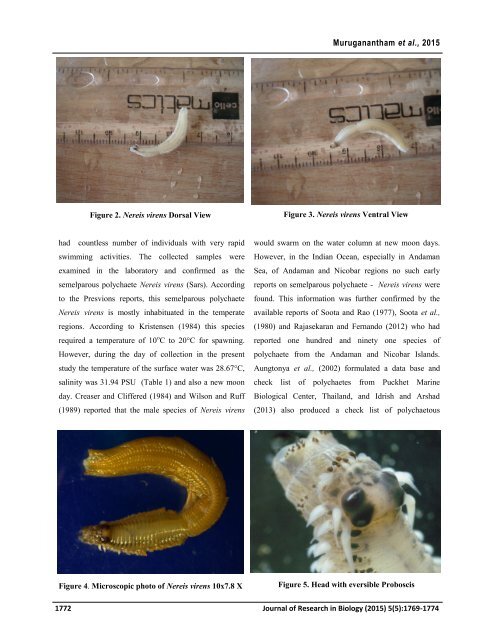First report of Nereis (Neanthes) virens (Sars) an epitoky
A sudden and mass outburst of the epitoky polychaete worm Nereis (Neanthes) virens (Sars)/ Alitta virens was observed of the surface waters of Middle Strait, Baratang, South Andaman Island during July 2014. This polychaeta worm was studied for its morphology and structural characteristics. We have taken nine consecutive seasonal samplings from July 2011 to January 2015, this was the first appearance of these worms in such a huge mass. These epitoky worms were observed in the month of July 2014 during monsoonal season in Andaman Nicobar Islands. Even though detailed studies were carried out on this worm in the world oceans, the present observation was the first report on the tropical island ecosystem of Andaman and Nicobar Islands.
A sudden and mass outburst of the epitoky polychaete worm Nereis (Neanthes) virens (Sars)/ Alitta virens was observed of the surface waters of Middle Strait, Baratang, South Andaman Island during July 2014. This polychaeta worm was studied for its morphology and structural characteristics. We have taken nine consecutive seasonal samplings from July 2011 to January 2015, this was the first appearance of these worms in such a huge mass. These epitoky worms were observed in the month of July 2014 during monsoonal season in Andaman Nicobar Islands. Even though detailed studies were carried out on this worm in the world oceans, the present observation was the first report on the tropical island ecosystem of Andaman and Nicobar Islands.
Create successful ePaper yourself
Turn your PDF publications into a flip-book with our unique Google optimized e-Paper software.
Murug<strong>an</strong><strong>an</strong>tham et al., 2015<br />
Figure 2. <strong>Nereis</strong> <strong>virens</strong> Dorsal View<br />
Figure 3. <strong>Nereis</strong> <strong>virens</strong> Ventral View<br />
had countless number <strong>of</strong> individuals with very rapid<br />
swimming activities. The collected samples were<br />
examined in the laboratory <strong>an</strong>d confirmed as the<br />
semelparous polychaete <strong>Nereis</strong> <strong>virens</strong> (<strong>Sars</strong>). According<br />
to the Presvions <strong>report</strong>s, this semelparous polychaete<br />
<strong>Nereis</strong> <strong>virens</strong> is mostly inhabituated in the temperate<br />
regions. According to Kristensen (1984) this species<br />
required a temperature <strong>of</strong> 10 o C to 20°C for spawning.<br />
However, during the day <strong>of</strong> collection in the present<br />
study the temperature <strong>of</strong> the surface water was 28.67°C,<br />
salinity was 31.94 PSU (Table 1) <strong>an</strong>d also a new moon<br />
day. Creaser <strong>an</strong>d Cliffered (1984) <strong>an</strong>d Wilson <strong>an</strong>d Ruff<br />
(1989) <strong>report</strong>ed that the male species <strong>of</strong> <strong>Nereis</strong> <strong>virens</strong><br />
would swarm on the water column at new moon days.<br />
However, in the Indi<strong>an</strong> Oce<strong>an</strong>, especially in Andam<strong>an</strong><br />
Sea, <strong>of</strong> Andam<strong>an</strong> <strong>an</strong>d Nicobar regions no such early<br />
<strong>report</strong>s on semelparous polychaete - <strong>Nereis</strong> <strong>virens</strong> were<br />
found. This information was further confirmed by the<br />
available <strong>report</strong>s <strong>of</strong> Soota <strong>an</strong>d Rao (1977), Soota et al.,<br />
(1980) <strong>an</strong>d Rajasekar<strong>an</strong> <strong>an</strong>d Fern<strong>an</strong>do (2012) who had<br />
<strong>report</strong>ed one hundred <strong>an</strong>d ninety one species <strong>of</strong><br />
polychaete from the Andam<strong>an</strong> <strong>an</strong>d Nicobar Isl<strong>an</strong>ds.<br />
Aungtonya et al., (2002) formulated a data base <strong>an</strong>d<br />
check list <strong>of</strong> polychaetes from Puckhet Marine<br />
Biological Center, Thail<strong>an</strong>d, <strong>an</strong>d Idrish <strong>an</strong>d Arshad<br />
(2013) also produced a check list <strong>of</strong> polychaetous<br />
Figure 4. Microscopic photo <strong>of</strong> <strong>Nereis</strong> <strong>virens</strong> 10x7.8 X<br />
Figure 5. Head with eversible Proboscis<br />
1772 Journal <strong>of</strong> Research in Biology (2015) 5(5):1769-1774
















